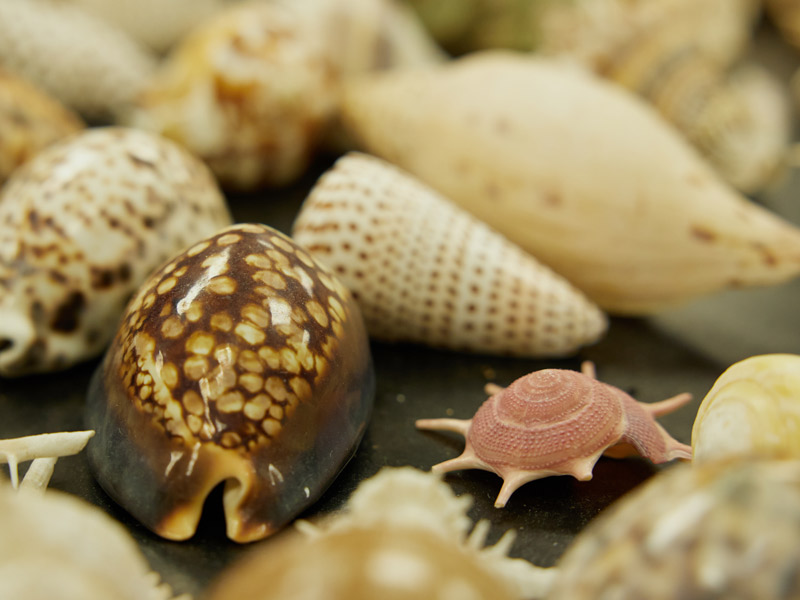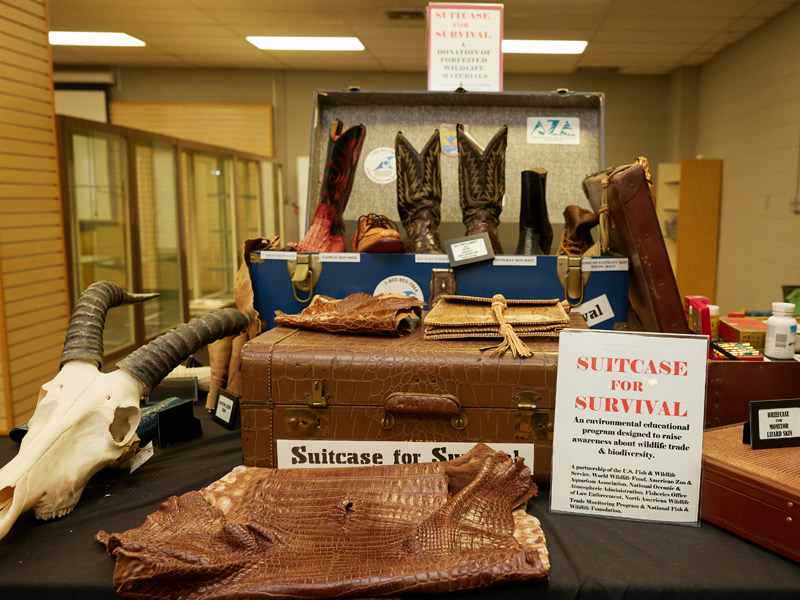Exhibits
Invertebrate Room
When you consider the many species that have roamed the planet for the past few millennia, many think of large cats, mammoths, or creatures of the sea. But at the Museum of Natural History, we display creatures from the past, and others that exist today; all without a skeleton! In our “No Bones Room”, also known as the Invertebrates Room, are housed various species of butterflies, stinging insects, and other biological creatures… all without bones! Within this room, one can discover organisms that lived in strange-shaped shells, existed as huge ocean coral, and compare various bright colored sea urchins and snail shells. 
However, if staying on land is your thing, you can examine the many types of beetles, stick-bugs, and arachnids found in and around the local area, some as big as a human hand! Our collection will also call your attention to the odd behaviors of insects and the ways they interact with plants and how some plants retaliate and protect themselves from these creepy-crawly creatures. Through interactive displays and kid-friendly “touch-table” panels, you will get a closer look at these species and learn about the importance and preservation of invertebrates from local and far away ecosystems.
Mammals
From the life-sized lion to the hippopotamus heads, the Museum of Natural History presents a wide variety of mammals for you to marvel at, including wildlife from North America, Asia, and Africa. Begin with the North American brown bear and its towering stature. See the head of a moose, measured at a staggering two and a half feet or gaze at the wild pig and his tusks. All of these and more mammals await as you tour the museum.
The adventure doesn’t end there! Examine the many patterns of Africa: the zebra and its black and white striations, the leopard with its black rings embellished along golden fur, the cheetah with its spotted mane. Dare to venture further, and you may find an Asian tiger waiting nearby!
As you explore this immersive exhibit, you’ll encounter skulls, furs, taxidermy mounts, and life-size replicas, bringing these creatures to life in intricate detail. Come visit the ULM Museum of Natural History and let the wonders of the animal kingdom inspire you!
Fish
Plunge into our fish exhibit as we showcase a variety of aquatic life from both fresh and saltwater ecosystems. Come and see preserved specimens including sharks, eels, and rays alongside our aquaria with live fish and sea anemones.
Our wall models display some of the most life-like and eye-catching native species of Louisiana and the Gulf of Mexico. Experience an exotic array of wet specimens, from freshwater bass to swordfish, and discover their unique adaptations. Do you know the difference between a Pufferfish, a sawfish, and a sailfish?
We have two aquaria simulating a marine and a freshwater rainforest environment, each populated with various species. These artificial biomes show off the spectacular color differences between life in these areas. From the small polyp stony coral to the beautifully patterned four-stripe damselfish, each displays its own beauty just waiting to be observed.
Fossils
Unearth the remains of our world’s natural history with a visit to our Fossils exhibit. Upon entering the museum, guests will be greeted by a one-to-one scale model of a megalodon’s jaw! You can learn about the fossilization process and explore our collection of fossilized bones from all around the world. We showcase fossilized whales from North Louisiana, and mammoth bones from dig-sites in Texas and Mississippi. Come and see casts of life-sized mammoths, tyrannosaurus, and allosaurus skulls!
We also have fossil replicas of the earliest known bird, the Archaeopteryx, which shared traits with both modern birds and ancient reptiles. Seeing is believing, so come and immerse yourself in the surprisingly large species of the prehistoric world!
Reptiles & Amphibians
Entering the reptile and amphibian exhibit, you can almost feel the gaze of the lifelike alligators, lying still as if sunning by a shore. Along the display tables amphibious creatures of every variety can be found and admired.
Frogs, toads, and salamanders can be discovered and inspected next to an especially unique five-legged bullfrog. Why does it have five-legs you ask? Caused by mutations due to exposure from chemical-based pesticides, this creature’s DNA caused the growth of an extra limb!
Children and other guests will enjoy pressing all the buttons within the display to hear how each different frog species calls its mate.
This area of the museum is also home to our live turtle named “Blondie”. She is a 3-toed Box Turtle that hatched in the summer of 2013. Upon request or when Blondie is in good spirits, the museum staff may even allow guests to interact with Blondie. Down from Blonde's terrarium, guests can explore various turtle shells and the skeleton of a massive alligator snapping turtle. Venomous and nonvenomous snakes, along with lizards, are also on display, offering insights into Louisiana's native and nonnative snakes and their diverse color patterns
Birds
“Bird World” is a vibrant, “backyard-like” experience that showcases bird species commonly found in Northern Louisiana. This dynamic room is also a kid-friendly area where guests may stroke loose feathers, hold select bird eggs, and view practical bird houses. Many displays include songbirds, ducks, and eagle specimens, preserved nests, and various bird eggs from an over 100-year-old collection.
Bird World also proudly highlights the unique history of the Louisiana state flag and the meaning for why the state bird, the brown pelican, was chosen as its focal point. This room will appeal to all ages, as various informational charts are on display as well as a copy of the Smithsonian Birds of North America. Be sure to look for your backyard friends when you visit this egg-straordinary exhibit!

Suitcase for Survival
Our “Suitcase for Survival” exhibit consists of various seized wildlife souvenirs that would be considered illegal in today’s world. Items featured in this display are dyed caiman boots, a sea turtle comb, and a snakeskin bag.
Consumers often enjoy the luxury or rarity of an item without considering how its consumption can threaten a species and its natural environment. This exhibit seeks to educate guests about the legal and financial consequences of buying/selling poached products and the dangers to the environment that entails.
Archaeology
Within the Museum of Natural History’s STEAM room, we enter the Archaeology Wing where we step back in time to learn about the history of Native American cultures in northeastern Louisiana. Walking through the exhibit takes visitors from the first people in Louisiana to today. The displays depict changes in how people occupied the landscape, the tools that were used in their daily lives, and their forms of artistic expression. Guests can view a range of artifacts, from projectile points and other stone tools to clay figurines and pottery sherds to stone beads and pendants. Artifacts from the Poverty Point World Heritage Site located near Epps, Louisiana, are highlighted. Guests will learn how the lives of indigenous people changed with the arrival of Spanish and French settlers and the establishment of Fort Miro, the precursor to Monroe, Louisiana. After facing many challenges, Louisiana’s tribes are flourishing today.